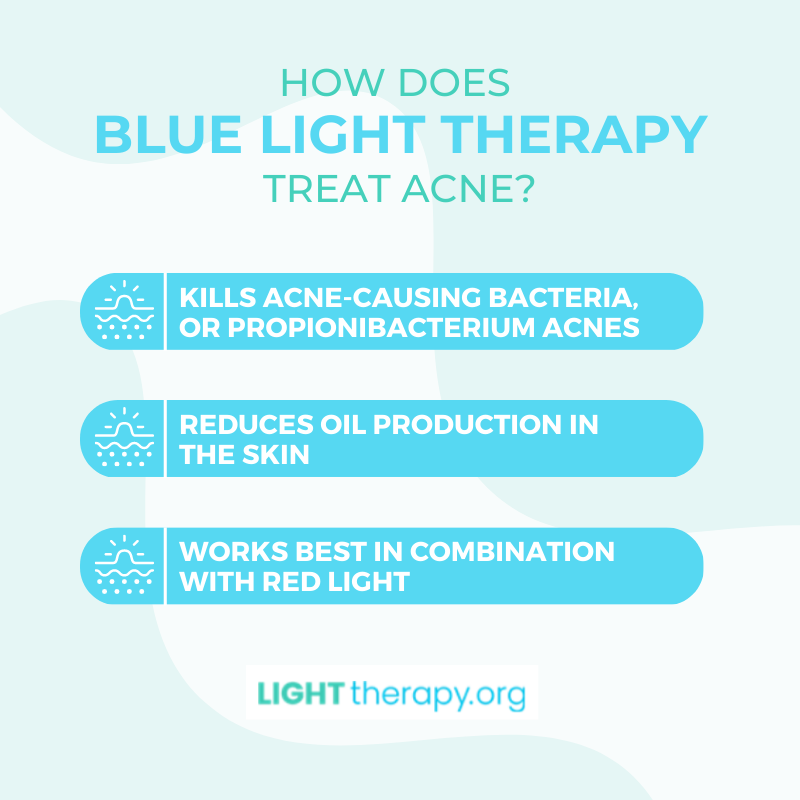Blue Light Therapy for Acne, Before and After: What to Expect
When a fresh acne breakout ruins your day, you’ll do just about anything to get rid of it.
Fortunately, there are many ways to manage acne that don’t involve taking extreme measures — it could be as simple as blue light therapy!
Clinical studies show blue light therapy effectively manages acne by killing acne-causing bacteria on your skin. But what does blue light therapy look like in action? By considering blue light therapy for acne before and after results, you can pursue treatment with realistic expectations.
Is Blue Light Therapy an Effective Acne Treatment?
Before examining blue light therapy for acne before and after results, let’s explore how blue light treats breakouts.
One of the main causes of acne breakouts is a bacteria called Propionibacterium acnes, or P. acnes. This bacteria sets up shop in clogged pores, and one of its favorite pastimes is ramping up inflammation in your skin. The result is a nasty breakout.
This is where blue light therapy can help. Certain wavelengths of blue light kill bacteria, including P. acnes. By killing P. acnes, blue light therapy helps existing blemishes to heal and prevents future breakouts altogether, which is great news for acne sufferers.
However, studies suggest the most effective light therapy treatments include a combination of blue and red light. While blue light kills acne-causing bacteria, red light swoops in to ease inflammation and promote healing, leaving your skin pimple-free. Together, blue and red light may also help reduce excess oil production, keeping pores from becoming clogged in the first place.
Other Factors to Consider
Another important factor in managing acne breakouts is how well you care for your skin in general and how consistent you are with your skincare routine. No matter how effective light therapy is, you still can’t skip the basics!
Dermatologists recommend you wash your face with a gentle cleanser in the morning and before bed, though be careful not to scrub or irritate your skin. Then, after applying your preferred acne-fighting medication, follow up with an oil-free moisturizer. All the products you use on your skin — from soaps to lotions to cosmetics — should be oil-free and non-comedogenic, meaning the ingredients won’t clog your pores and lead to further breakouts.
For daytime, dermatologists strongly recommend using sunscreen to protect your skin from damaging UV rays. For nighttime, they suggest using a retinol product to help manage existing breakouts.
Some cleansers, moisturizers, and sunscreens may contain additional acne-fighting ingredients that can be harsh on your skin, such as salicylic acid or benzoyl peroxide. While acne-fighting ingredients can manage breakouts, exposing your skin to too many of these chemicals can cause unwanted side effects. You may experience excessive dryness or damage your skin’s natural barrier — both of which can actually worsen breakouts!
Blue Light Therapy for Acne: Before and After Results
Now that you know how to care for acne-prone skin, let’s go over what to expect when you use blue light therapy as an additional treatment option.
When you’re considering blue light therapy, or any kind of acne-fighting treatment, try finding reliable before and after photos of real people who have pursued this treatment option. Pay close attention to those whose breakouts appear similar to yours. Viewing photos of real patients is an excellent way to gauge if a treatment option might be right for you.
One of the best ways to find before and after photos is by using the Google image search tool. For copyright reasons, we can’t publish blue light therapy for acne before and after images directly to this blog, but you can use this link to take a look at the search results yourself.
When you search for “blue light therapy for acne before and after,” the Google image tool pulls photos of real patients from all across the web and arranges them in order of relevance.
As you peruse the photos, remember that websites that manufacture and sell blue light therapy devices publish many of the images you see on Google. These websites are more likely to present a biased view than other sources, such as independent studies. That’s not to say that commercial companies’ images are necessarily fictitious, just that it’s hard to know for sure.
In general, trust the results presented by researchers over those presented by companies that have a financial incentive to present positive images.
While clinical studies (such as this one published in the Journal of Clinical and Aesthetic Dermatology) are less likely to present biased results, bear in mind that some studies are more rigorous than others. Consider the researchers’ methodology and criteria for participants, as well as the length of the study.
Results May Vary
Ultimately, what you actually experience from blue light therapy for acne and your before and after results will vary based on many factors.
Like all acne treatment options, the effectiveness of blue light therapy is dependent upon the individual. Many reputable sources have verified the efficacy of blue light therapy for acne, but at the end of the day, the results depend on the severity and causes of your acne, what else you’re doing to take care of your skin, and how consistent you are with your skincare routine.
Final Thoughts
If you’re willing to do your due diligence and put in the effort to achieve clear, acne-free skin, blue light therapy may be an excellent option to add to your routine!
